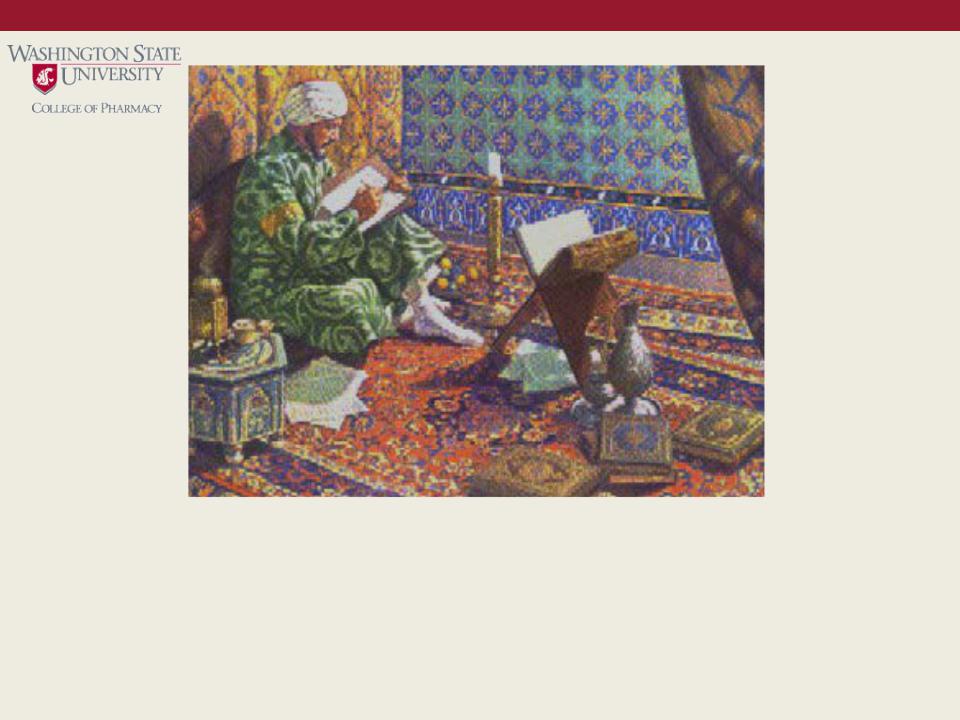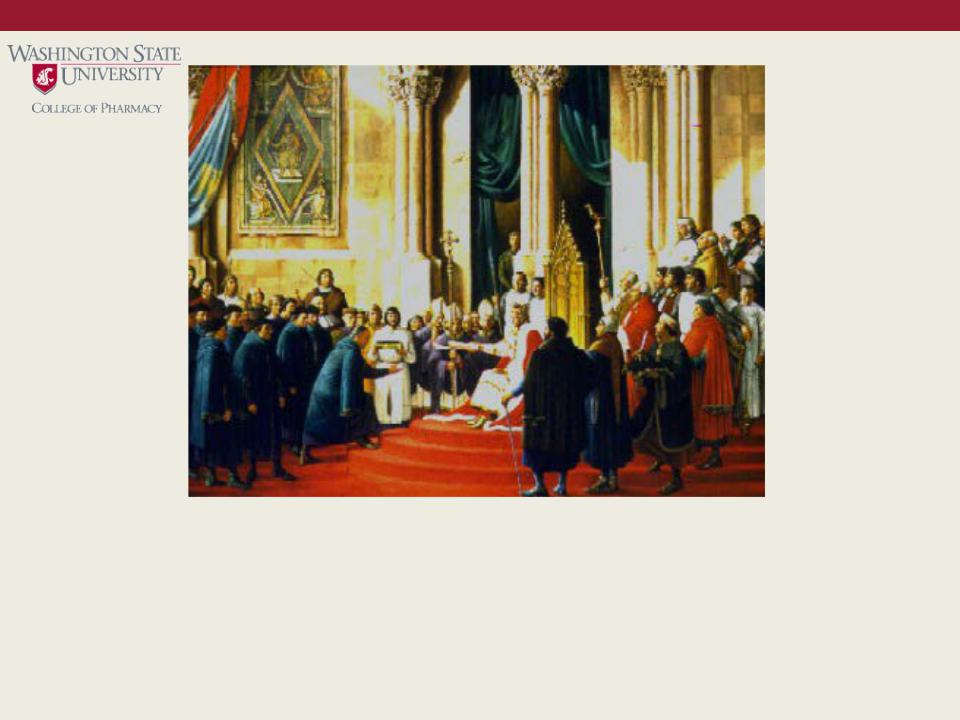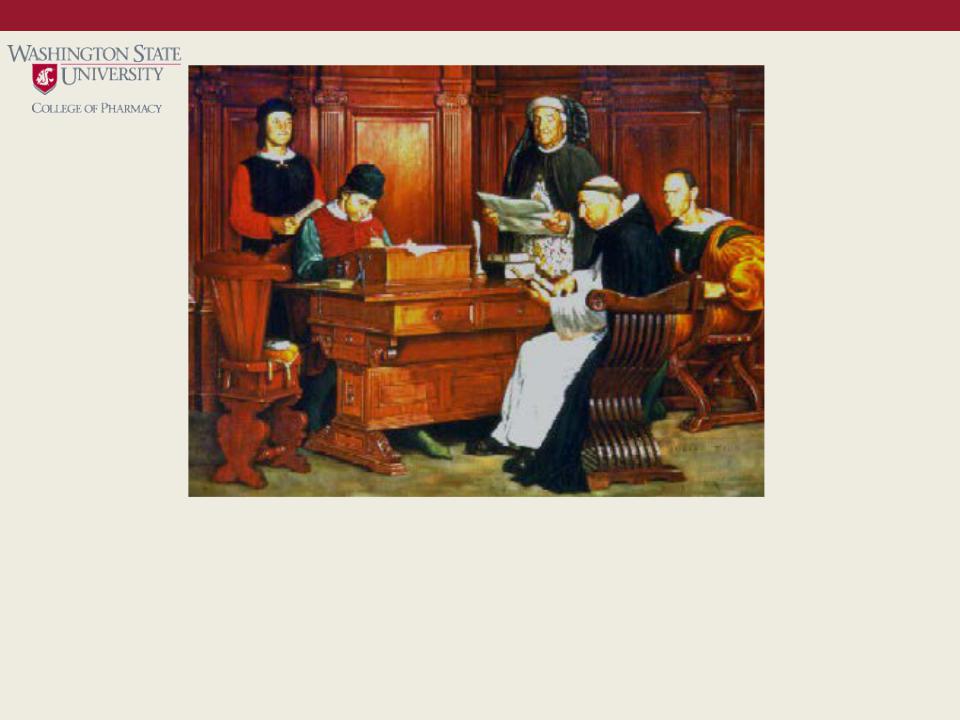
- •1. Before the Dawn of History
- •2. Pharmacy in Ancient Babylonia
- •3. Pharmacy in Ancient China
- •4. Days of the Papyrus Ebers
- •5. Theophrastus – Father of Botany
- •6. The Royal Toxicologist – Mithridates VI
- •7. Terra Sigillata – An Early “Trademarked” Drug
- •8. Dioscorides – A Scientist Looks at Drugs
- •9. Galen – Experimenter in Drug Compounding
- •10. Damian and Cosmas – Pharmacy’s Patron Saints
- •11. Monastic Pharmacy
- •12. The First Apothecary Shops
- •13. Avicenna – The “Persian Galen”
- •14. Separation of Pharmacy and Medicine
- •15. The First Official Pharacopeia
- •16. The Society of Apothecaries of London
- •17. Louis Hébert, Apothecary to New France (Canada)
- •18. The Governor who Healed the Sick
- •19. The Marshall Apothecary
- •20. First Hospital in Colonial America
- •21. Scheele – Greatest of the Pharmacists-Chemists
- •22. Craigie – America’s First Apothecary General
- •23. Sertürner – First of the Alkaloid Chemists
- •24. Caventou, Pelletier and Quinne
- •25. American Pharmacy Builds its Foundations
- •26. The Shakers and Medicinal Herbs
- •27. The American Pharmaceutical Association
- •28. European and American Pharmacy Meet
- •29. The Father of American Pharmacy
- •30. A Revolution in Pharmaceutical Education
- •31. The Pharmacopeia Comes of Age
- •32. The Standardization of Pharmaceuticals
- •33. Wresting the Jungle’s Secrets
- •34. Stanislas Limousin – Pharmacal Inventor
- •35. The Era of Biologicals
- •36. The Development of Chemotherapy
- •37. Pharmaceutical Research
- •38. Pharmaceutical Manufacturing Comes of Age
- •39. The Era of Antibiotics
- •40. Pharmacy Today and Tomorrow

13. AVICENNA – THE “PERSIAN GALEN”
Among the brilliant contributors to the sciences of Pharmacy and Medicine during the Arabian era was one genius who seems to stand for his time - the Persian, Ibn Sina (about 980-1037 A.D.), called Avicenna by the Western world. Pharmacist, poet, physician, philosopher and diplomat, Avicenna was an intellectual giant, a favorite of Persian princes and rulers. He wrote in Arabic, often while secluded in the home of an apothecary friend. His pharmaceutical teachings were accepted as authority in the West until the 17th century; and still are dominant influences in the Orient.

14. SEPARATION OF PHARMACY AND MEDICINE
In European countries exposed to Arabian influence, public pharmacies began to appear in the 17th century. However, it was not until about 1240 A.D. that, in Sicily and southern Italy, Pharmacy was separated from Medicine. Frederick II of Hohenstaufen, who was Emperor of Germany as well as King of Sicily, was a living link between Oriental and Occidental worlds. At his palace in Palermo, he presented subject Pharmacists with the first European edict completely separating their responsibilities from those of Medicine, and prescribing regulations for their professional practice.

15. THE FIRST OFFICIAL PHARACOPEIA
The idea of a pharmacopoeia with official status, to be followed by all apothecaries, originated in Florence. The Nuovo Receptario, originally written in Italian, was published and became the legal standard for the city-state in 1498. It was the result of collaboration of the Guild of Apothecaries and the Medical Society - one of the earliest manifestations of constructive interprofessional relations. The professional groups received official advice and guidance from the powerful Dominican monk, Savonarola, (seated, foreground) who, at the time, was the political leader in Florence.

16. THE SOCIETY OF APOTHECARIES OF LONDON
Trade in drugs and spices was lucrative in the Middle Ages. In the British Isles, it was monopolized by the Guild of Grocers, which had jurisdiction over the apothecaries. After years of effort, the apothecaries found allies among court physicians. King James I, flanked by two "Beefeaters" wore heavily padded attire because of fear of stabbing. Upon persuasion by the philosopher-politician, Francis Bacon, the King granted a charter in 1617 which formed a separate company known as the "Master, Wardens and Society of the Art and Mystery of the Apothecaries of the City of London" over vigorous protests of the grocers. This was the first organization of pharmacists in the Anglo-Saxon world.
